
Bosnian Cyrillic, widely known as Bosančica, is a variant of the Cyrillic alphabet that originated in medieval Bosnia. The term was coined at the end of the 19th century by Ćiro Truhelka. It was widely used in modern-day Bosnia and Herzegovina and the bordering areas of modern-day Croatia. Its name in Serbo-Croatian is Bosančica and Bosanica the latter of which might be translated as Bosnian script. Serb scholars call it Serbian script, Serbian–Bosnian script, Bosnian–Serb Cyrillic, as part of variant of Serbian Cyrillic and deem the term "bosančica" Austro-Hungarian propaganda. Croat scholars also call it Croatian script, Croatian–Bosnian script, Bosnian–Croat Cyrillic, harvacko pismo, arvatica or Western Cyrillic. For other names of Bosnian Cyrillic, see below.
Stari Grad is a town on the northern side of the island of Hvar in Dalmatia, Croatia. One of the oldest towns in Europe, its position at the end of a long, protected bay and next to prime agricultural land has long made it attractive for human settlement. Stari Grad is also a municipality within the Split-Dalmatia County.

The Trpimirović dynasty was a native Croatian dynasty that ruled in the Duchy and later the Kingdom of Croatia, with interruptions by the Domagojević dynasty from 845 until 1091. It was named after Trpimir I, the first member and founder. The most prominent rulers of the Trpimirović Dynasty include Tomislav, Petar Krešimir IV and Demetrius Zvonimir. The house gave four dukes, thirteen kings and a queen.
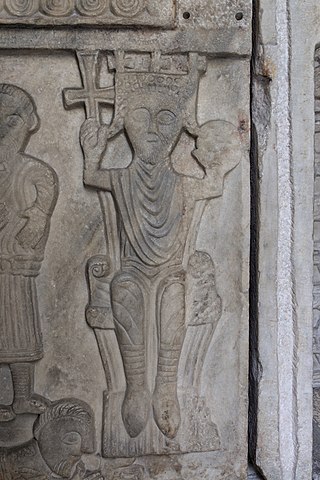
Demetrius Zvonimir was a King of Croatia and Dalmatia from 1075 or 1076 until his death in 1089. Zvonimir also served as Ban of Croatia (1064–1074), and was named Duke of Croatia in around 1075. His native name was Zvonimir, but adopted the forename Demetrius at his coronation.
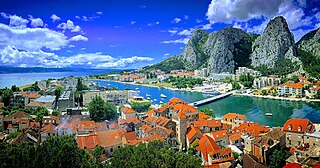
Omiš is a town and port in the Dalmatia region of Croatia, and a municipality in the Split-Dalmatia County. The town is approximately 25 kilometres south-east of Croatia's second largest city, Split, where the Cetina River meets the Adriatic Sea. Omiš municipality has a population of 14,936 and its area is 266 square kilometres (103 sq mi).

The history of Bosnia and Herzegovina in the Middle Ages refers to the time period between the Roman era and the 15th-century Ottoman conquest. The Early Middle Ages in the Western Balkans saw the region reconquered from barbarians (Ostrogoths) by the Byzantine Emperor Justinian I, followed by raids and migrations carried out by Slavic peoples in the 6th and 7th centuries. The first mention of a distinct Bosnian region comes from the 10th-century Byzantine text De Administrando Imperio. By the late 9th and early 10th century, Latin priests had Christianized much of Bosnia, with some areas remaining unconverted. In the High Middle Ages, Bosnia experienced economic stability and peace under the Ban Kulin who ruled over Banate of Bosnia from 1180 to 1204 and strengthened its ties with the Republic of Ragusa and with Venice. The Kingdom of Bosnia emerged in the Late Middle Ages (1377). The kingdom faced internal and external conflicts, eventually falling under Ottoman rule in the late 15th and early 16th centuries.
Matko Talovac or Matija Talovac, was a Croatian nobleman, a member of the Talovac noble family. He served as Ban (Viceroy) of Slavonia from 1435 and Ban of Croatia from 1436, until his death in 1444 or 1445.

The Republic of Poljica or duchy was an autonomous community which existed in the late Middle Ages and the early modern period in central Dalmatia, near modern-day Omiš, Croatia.
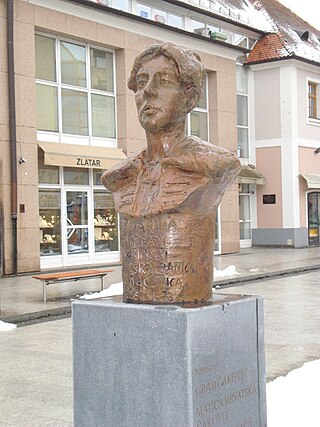
Countess Ana Katarina Zrinska was a Croatian noblewoman and poet, born into the House of Frankopan, Croatian noble family. She married Count Petar Zrinski of the House of Zrinski in 1641 and later became known as Katarina Zrinska. She is remembered in Croatia as a patron of the arts, a writer and patriot. She died in obscurity in a monastery in Graz following the downfall of the Zrinski-Frankopan conspiracy in 1671 and the execution of both her husband Petar Zrinski and her brother Fran Krsto Frankopan. Her most notable literary work is Putni tovaruš, written 1660 at her estates in Ozalj.

Petar Skok was a Croatian linguist and onomastics expert.
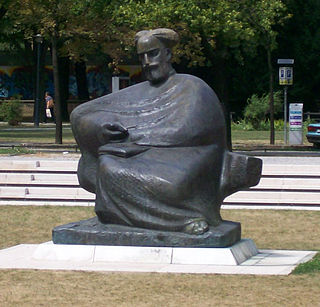
Croatian Latin literature is a term referring to literary works, written in the Latin language, which have evolved in present-day Croatia since the 9th century AD. Since that time, both public and private documents have been written in a local variant of medieval Latin or in later times Neo-Latin. Some works have been found which were written in a variant more closely resembling classical Latin.
Croatian names follow complex and unique lettering, structuring, composition, and naming customs that have considerable similarities with most other European name systems and with those of other Slavic peoples in particular.
Croatian literature refers to literary works attributed to the medieval and modern culture of the Croats, Croatia, and Croatian. Besides the modern language whose shape and orthography were standardized in the late 19th century, it also covers the oldest works produced within the modern borders of Croatia, written in Church Slavonic and Medieval Latin, as well as vernacular works written in Čakavian and Kajkavian dialects.
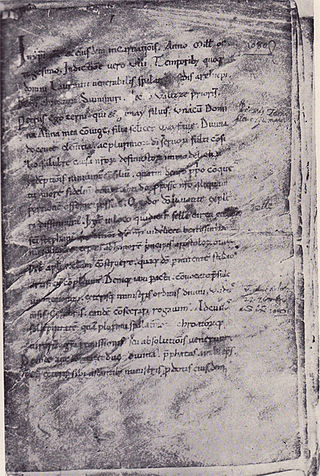
Supetar cartulary or Sumpetar cartulary is a 12th-century cartulary which contains charters from the years 1080 to 1187.

The Kačić family was one of the most influential Croatian noble families, and was one of the Croatian "twelve noble tribes" described in the Pacta conventa and Supetar Cartulary. Historical sources refer to members of this family as nobles in the area of the Luka županija in the Zadar-Biograd hinterland, as the lords (knezes) of Omiš, and as the lords of the Makarska Riviera. Another prominent branch of the family, Kacsics, was part of the Hungarian nobility and from it branched many families including Szécsényi.

The Gusić family, also known as Gušić, was one of the twelve noble tribes of the Kingdom of Croatia, mentioned in the Pacta conventa. They originated from the hinterland of Biograd in the medieval Luka and Sidraga županijas, where they are recorded at least since the 11th century. Their main regions of influence were Krbava and Gacka, where they often served as župans and knezes at least since the early 13th century. In the 14th century branched Posedarski who seated in Posedarje, and Kurjakovići who as magnates managed to gather much wealth and have high official positions at the Hungarian royal court as well two of their members became Ban of Croatia. As experienced warriors, they actively participated in the Croatian–Ottoman and late Ottoman–Venetian Wars. Direct descendants of the tribe with the surname Gusić, and possibly Gušić, live even today in Croatia and Slovenia.

The Mogorović family was one of the twelve noble tribes of the Kingdom of Croatia, mentioned in the Pacta conventa and Supetar Cartulary. They were initially mentioned in the 12th and 14th centuries in the hinterland of Biograd na Moru and Zadar in Dalmatia, and since the 13th century in the region of Lika, where they branched into most prominently Disislavić noble family, besides being divided into other fourteen noble branches by 15th and 16th century. As experienced warriors, they actively participated in the Croatian–Ottoman wars. Direct descendants of the tribe live even today in Croatia.
The Čudomirić family was one of the twelve noble tribes of the Kingdom of Croatia, mentioned in the Pacta conventa and Supetar Cartulary.

The Lapčan family was one of the twelve noble tribes of the Kingdom of Croatia, mentioned in the Pacta conventa. Their seat was in the town of Lapac in the former Luka županija, Dalmatia. Their noble rights were confirmed in the second half of the 13th century until when were jobbágy. In the 14th century branched Karinjani, with seat in Karin, whose name would eventually become more dominant than of Lapčan. The family's coat of arms is described in the 15th century and united with the one by Kurjaković family in the mid-17th century, it became used by the Austrian-Bavarian Sinzendorf noble family.

The House of Knežević was a Croatian noble family, descending from the medieval village of Broćno (Brotnjo) at Čitluk, Herzegovina. First mentioned there in the 15th century, family moved in the second half of the century towards northwest, where the members of the family gained new estates from the king Matthias Korvin in Gračac and Grab in the Lika Region. During the following centuries, they were appointed to various military and other services in the Habsburg monarchy army. At the beginning of the 19th century some of the distinguished family members, being notable high-ranking army officers, moved to Međimurje, the northernmost part of Croatia, where they acquired new possessions. The last of them, Ivo Knežević, died in 1924 without leaving a successor.